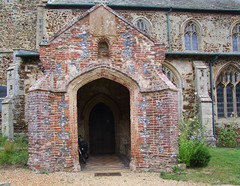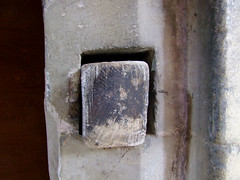| |
|
All
Saints, East Winch
 |
|
And
so, a few days after visiting West Winch I came
to East Winch. 'Winch', or so the Oxford
Dictionary of Placenames tells me, is a
contraction of Win-Wich, a farmstead
with meadowlands. Barely four miles separate
them, but both are set on spectacularly busy
roads. It is the A10 London to King's Lynn road
which forms West Winch's main street, and here at
East Winch it is the A47, the main road from the
Midlands to Norwich and Great Yarmouth. Whatever
must it be like to live in a place like East
Winch? The hellish traffic is funnelled through
the little village, slowed to a mere fifty miles
an hour as it hurtles past the houses. If a car
hits you at fifty miles an hour there is no way
you are going to survive. They'd be collecting
you in little pieces. I live ten minutes walk
from the centre of Ipswich, but it was quite safe
for my children to play out in the street. If I'd
lived in East Winch I don't think I'd have dared
let them out of the house. Anyway, All
Saints sits above the busy road. It's a big
church, the full-blown Perpendicular of the end
of the 14th Century and the start of the next.
The sanctus bell turret was happily restored to
it by the Victorians, and that great tower has a
stair turret runing all the way up it to buttress
it at the south-west corner. All in all, the
effect from a distance is something like a
castle, solid and permanent. This idea of a
fortress may be reinforced by the fact that the
draw-bar still sits in its slot in the south
doorway, but in fact the church is open every
Saturday, as the nice lady who'd just opened up
was pleased to tell me, and there's a keyholder
notice for other times. And as it happened, she
was from Ipswich too.
|
The
grandness of the church may be explained by the fact that
East Winch was the home parish of the Howards, the Dukes
of Norfolk, and their memorials were in a chapel at the
east end of the south aisle. This had fallen into decay
by the 18th Century, and in 1875 a big restoration of the
church by George Gilbert Scott replaced it somewhat
prosaically with an organ chamber.
The first
impression on stepping inside is of a slightly faded
grandeur. The font panels bear the shields of the
Howards, a reminder of past glories. The arcades pace
majestically eastwards towards the long chancel, the
aisles filled with mottled light from coloured and clear
glass. Ninian Comper's font cover from the eve of the
First World War sets the tone, speaking of that period of
triumphalism in the Church of England when anything must
have seemed possible. Turning east, the view is
inexorably drawn to the great five-light window in the
chancel, the wholly excellent 1876 work of Clayton &
Bell, the workshop at its very best. Christ the Good
Shepherd, always a difficult subject, is flanked by the
parable of the Good Samaritan on one side and the Parable
of the Wise and Foolish Virgins on the other. It is
original and innovative work, finely drawn.
  
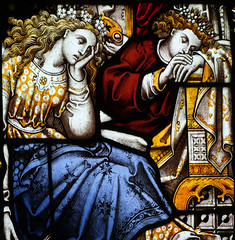 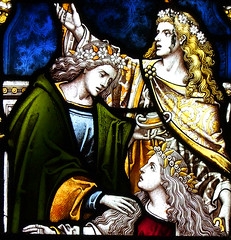 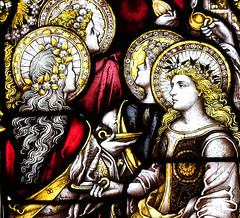
 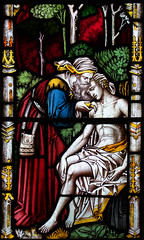 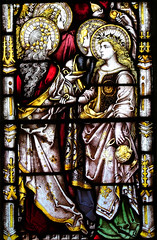 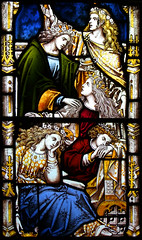
Less
happy, perhaps, is Ward & Hughes 1901 glass of the
risen Christ flanked by two angels, but it is interesting
as an example of something that happened around the turn
of the Century and continued until the First World War.
This was that, again and again, angels became effeminate
and then actually female. Gone were the manly figures of
the earlier Victorian period, and it was not until the
1920s that angels became masculine, strong and fearsome
again. This tendency is observable across all the major
workshops of the period. I don't know why it happened. I
expect the angels here provided something of a
distraction to the repressed Edwardian male during the
Sunday sermon.
There are
two very good 13th Century coffin lids at the east end of
the north aisle. One is deeply cut with a floriated
cross, roses and what appear to be an axe and a set
square. The other has two omega symbols in relief, back
to back.
| The
Howard memorials were lost centuries ago, but it
is worth squeezing behind the organ to see
something else. Beyond the simple brass plaque
that notes the site of the Howard graves, and
partly hidden by a fuse box, is a memorial to
William Barnes, who died in 1657. It tells us
that he did for
many years serve his king and country with great
prudence and fidelity in ye office of justice of
the peace, till at length, such was ye iniquity
of ye times that loyalty was esteemed a crime,
when noe allurements or threats from him who
usurped ye highest power could seduce him from
his constant adhearance to his abandoned prince
and the persecuted Church of England. He retired
to a private life, devoting himself wholly to the
service of God and religion, and peaceably
departed hence in 1657, in the 77th year of his
age, expecting a joyful resurrection. I
assume it was made after the Restoration, but I
wonder how it ended up at the back of the 1875
organ chamber? Lady
Harrod enjoyed pointing out in The Shell
Guide to Norfolk that the Lord of the Manor
here was her good friend the cartoonist and wit
Sir Osbert Lancaster. He is buried at West Winch.
|
|
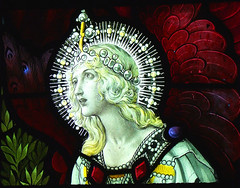 |
|
|
|

